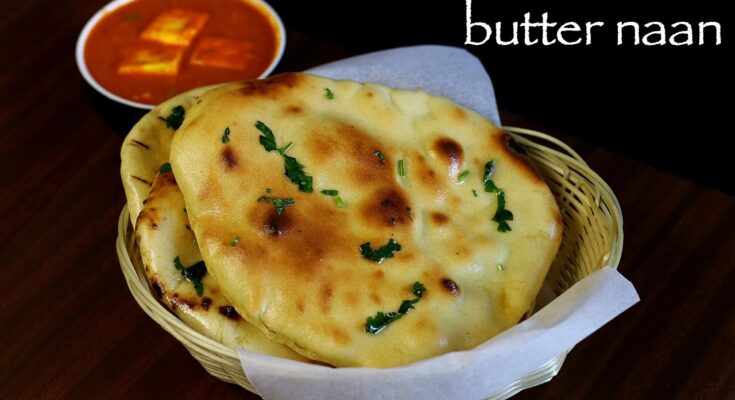Naan Recipe: Naan is a soft, fluffy flatbread originating from India, cherished worldwide for its unique texture and flavor. Traditionally, naan is cooked in a tandoor, a clay oven that reaches extremely high temperatures, giving the bread its signature charred bubbles and chewy texture.
While popular in Indian cuisine, naan is enjoyed across various cultures and can be customized with toppings like garlic, butter, and cheese. Its versatility allows it to complement a variety of dishes, from spicy curries to grilled meats.
In this guide, we’ll walk through the steps to make naan at home, ensuring you get that authentic, restaurant-quality result.
Essential Ingredients for Naan
To make naan, you’ll need a few simple ingredients:
- Flour: All-purpose flour is commonly used, but bread flour can add extra chewiness.
- Yeast: For a light, airy texture, yeast is essential.
- Water and Milk: A mix of water and milk provides the necessary moisture for soft dough.
- Yogurt: Adds tanginess and tenderness to the bread.
- Sugar and Salt: Sugar aids in fermentation, and salt enhances flavor.
- Oil or Butter: For a soft, moist finish and to keep the dough from drying.
Optional flavorings include garlic, herbs, and spices to add unique tastes.
Choosing the Right Flour
Choosing the right flour significantly impacts naan’s texture. All-purpose flour is popular due to its availability and balanced gluten content, resulting in a soft yet chewy bread. For an extra chewy texture, bread flour can be used. It has a higher protein content, creating more gluten and giving naan a delightful chew. Sifting the flour before use can also improve the texture, making it lighter and easier to mix.
Types of Naan Cooking Techniques
Traditionally, naan is cooked in a tandoor, which yields the best results. However, most home kitchens don’t have tandoors, so we can use a stove-top or an oven instead. Each method has its nuances:
- Stove-top: Gives you control over heat and works well for soft naan with slight char.
- Oven: Using a baking stone or pizza stone can replicate a tandoor’s high heat, yielding crispy, slightly chewy naan.
- Tandoor: If you have access to a tandoor or a portable clay oven, this provides the closest flavor to restaurant naan.
Step-by-Step Naan Recipe Guide
Step 1: Preparing the Dough
In a large mixing bowl, combine the following:
- 2 cups of flour
- 1 teaspoon of yeast (activated in warm water)
- 1/2 cup of water
- 1/4 cup of yogurt
- 1 tablespoon of oil or melted butter
- 1 teaspoon each of sugar and salt
Activate the yeast in warm water with a pinch of sugar until it becomes foamy, which can take 5–10 minutes. Combine the yeast mixture with the other ingredients, gradually adding the water to achieve a smooth, sticky dough. The yogurt helps soften the dough, while the butter or oil gives a subtle richness.
Step 2: Kneading the Dough
Kneading is crucial for developing gluten, which gives naan its characteristic chewy texture. You can knead by hand or use a stand mixer. Knead the dough for about 8–10 minutes until it becomes smooth, stretchy, and elastic. A good test for proper kneading is the windowpane test: stretch a piece of dough between your fingers; if it forms a thin, translucent layer without tearing, it’s ready.
Step 3: Letting the Dough Rise
Place the dough in a lightly greased bowl, cover it with a damp cloth, and let it rise in a warm area for about 1–2 hours, or until it doubles in size. The rising process allows the yeast to ferment, giving naan its airy texture. To check if the dough has risen enough, gently press a finger into it; if the indentation remains, it’s ready for the next step.
Step 4: Dividing and Shaping the Dough
Once the dough has risen, punch it down gently to release excess gas. Divide it into 6–8 equal portions, rolling each into a ball. To shape each naan, roll a ball on a floured surface, using your hands to stretch it into a teardrop shape. Keep the thickness around 1/4 inch for a soft texture, or roll thinner if you prefer a crispier result.
Step 5: Cooking Naan on the Stove
To cook naan on a stove-top, heat a skillet or non-stick pan over medium-high heat. Place a rolled-out naan on the hot pan. You should see bubbles forming on the surface. Flip it after 1–2 minutes, and cook the other side until both sides have golden spots. For extra flavor, brush each side with melted butter or garlic butter as it cooks.
Step 6: Cooking Naan in the Oven
Preheat your oven to 500°F (260°C) and place a baking stone or an upside-down baking sheet inside to heat up. Once hot, place the naan on the stone and bake for 2–3 minutes, or until it puffs up and browns. Flip and cook for an additional 1–2 minutes. The high heat mimics a tandoor, creating a crispy exterior and soft, chewy interior.
Step 7: Using the Tandoor for Authentic Flavor
For those with access to a tandoor, this method yields the most authentic results. Press the naan dough against the hot walls of the tandoor. It cooks quickly, forming charred bubbles. At home, you can create a similar effect by using a charcoal grill or a high-heat oven.
Flavoring Variations
Customize naan with various flavors to suit your taste:
- Garlic naan: Brush with minced garlic and butter.
- Cheese naan: Add grated cheese inside before rolling.
- Herb naan: Sprinkle chopped cilantro or parsley on the dough before cooking. For finishing touches, brush with melted butter, ghee, or a sprinkle of sea salt.
Serving Suggestions for Naan
Naan is traditionally served with a range of Indian curries like butter chicken, paneer tikka masala, or dal makhani. It’s also delicious with yogurt-based dishes and chutneys. Serve naan warm for the best texture and flavor. You can cut it into wedges for sharing or leave it whole to tear and dip into sauces.
Storing Leftover Naan
Store any leftover naan by wrapping it in foil or placing it in an airtight container. It can last up to 2 days at room temperature, or up to a month in the freezer. To reheat, wrap it in foil and warm it in the oven, or heat it on the stovetop with a bit of butter to restore its softness.
FAQs about Naan Recipe
What is Naan?
Naan is a soft, pillowy flatbread that originates from South Asia and the Middle East. Traditionally cooked in a clay tandoor oven, it’s known for its fluffy texture and slightly charred flavor, making it a popular accompaniment to curries and dips.
What ingredients are typically in Naan?
Common ingredients include flour, yeast, yogurt, water, and a touch of sugar or honey to aid in fermentation. Some recipes also include garlic, butter, or ghee for added flavor.
Can I make Naan without a tandoor?
Yes, you can cook Naan in a regular skillet or on a stovetop griddle. While it won’t have the exact texture of a tandoor-baked Naan, it will still be delicious and achieve that familiar soft, fluffy result.
How do I make Naan soft?
Using yogurt and a little oil or butter in the dough keeps the Naan soft and tender. Letting the dough rest to rise also helps in creating that airy, fluffy texture.
Can I freeze Naan?
Absolutely! After cooking, allow Naan to cool completely, then store it in airtight containers or freezer bags. When ready to eat, reheat it in the oven or a skillet for a freshly baked taste.
What are some variations of Naan?
Naan can be made with garlic, herbs, or cheese for extra flavor. You might also find stuffed Naan varieties, such as paneer (Indian cheese), potato, or spiced meat fillings.
Conclusion
Making naan at home may take a bit of time, but the delicious, fresh results are well worth the effort. Experiment with different flavors and toppings to create your ideal version of this versatile bread. Whether you’re cooking naan on the stovetop, in the oven, or in a tandoor, following these steps will help you enjoy authentic, restaurant-style naan anytime.
References
For readers looking to delve deeper and validate the steps and ingredients mentioned, here are some trusted sources that offer further insights and variations for preparing a delicious naan recipe:
- AllRecipes – A comprehensive resource for traditional naan recipes, variations, and helpful user reviews.
- BBC Good Food – Offers expert advice on techniques and tips to achieve the perfect texture for naan.
- Bon Appétit – Provides unique twists on classic naan, as well as chef-approved tips.
- Serious Eats – A trusted source for culinary science, including in-depth articles on the best methods for cooking naan.
These references not only enhance the authenticity of the recipe but also allow readers to explore a variety of methods to suit their taste preferences.



